Science
A mother's loss launches a global effort to fight antibiotic resistance

In November 2017, days after her daughter Mallory Smith died from a drug-resistant infection at the age of 25, Diane Shader Smith typed a password into Mallory’s laptop.
At this point, keeping myself alive is a full-fledged mission, enlisting all of my energy and hours every day. I need to fight the chronic deadly resistant bacteria eating away at my fragile, scarred lungs. Fight the billions of bacteria overtaking my lungs and clear out the mucus so I don’t feel like I’m breathing through a straw with a boulder weighing on my chest.
— Mallory Smith, Oct. 16, 2014
Her daughter gave it to her before undergoing double-lung transplant surgery, with instructions to share any writing that could help others if she didn’t survive.
Had this idea today that I wanted to write down before it leaves my mind or I stop feeling inspired or I forget it or something inside me tells me it’s not possible. I want to start an online media source (podcast? website?) that tells the stories of people who have struggled with something in their life and found hope somewhere.
— Mallory Smith, July 20, 2015
The transplant was successful, but Burkholderia cepacia — an antibiotic-resistant bacterial strain that first colonized her system when she was 12 — took hold. After a lifetime with cystic fibrosis, and 13 years battling an unconquerable infection, Mallory’s body could take no more.
Cepacia has taken over, and it’s time to figure out a transplant option. I realize I want to write my story.
— Mallory Smith, July 29, 2016
In the haze of grief and pain, Shader Smith found herself looking through 2,500 pages of a journal her daughter had kept since high school. It chronicled Mallory’s hopes and triumphs as an ebullient, athletic student at Beverly Hills High School and Stanford University, and her private despair as bacteria ravaged her systems and sapped her considerable strength.
In the years since, the journal has become a source of solace for Shader Smith as she has traveled the globe speaking about the growing threat of antimicrobial resistance. It is also now the inspiration for two new projects she hopes will spark greater understanding of the public health crisis that ended her daughter’s life prematurely and could claim millions more.
“Diary Of A Dying Girl” excerpts Mallory Smith’s own writings, which chronicle her 13-year battle against an antibiotic-resistant lung infection.
(Genaro Molina / Los Angeles Times)
On Tuesday, Random House published “Diary of a Dying Girl,” a selection of Mallory’s journal entries. The same day saw the launch of the Global AMR Diary, a website collecting the worldwide stories of people battling pathogens that can’t be defeated by our current pharmaceutical arsenal.
An estimated 35,000 people die in the U.S. each year from drug-resistant infections, according to the U.S. Centers for Disease Control and Prevention. Worldwide, antimicrobial resistance kills an estimated 1.27 million people directly every year and contributes to the deaths of millions more.
Despite the mounting toll — and the prospect of an eventual surge in superbug fatalities — the development of new antibiotics has stagnated.
Shader Smith is acutely aware of what we stand to lose when medicine can no longer save us.
“I don’t want to live in a post-antibiotic world,” Shader Smith said. “Until people understand what’s at stake, they’re not going to care. My daughter died from this. So I care deeply.”
Over the last 50 years, opportunistic pathogens have evolved defenses faster than humans can develop drugs to combat them.
Misuse of antibiotics has played a large part in this imbalance. Bugs that survive antibiotic exposure pass on their resistant traits, leading to hardier strains.
Crucial as they are, antibiotics don’t have the same financial incentives for developers that other drugs do. They aren’t meant to be taken over the long term, as are medications for chronic conditions such as diabetes or high blood pressure. The most powerful ones have to be used as rarely as possible, to give bacteria fewer opportunities to develop resistances.
“The public does not understand [the] scope of the problem. Antimicrobial resistance truly is one of the leading public health threats of our time,” said Emily Wheeler, director of infectious disease policy at the Biotechnology Innovation Organization. “The pipeline for antibiotics today is already inadequate to address the threats that we know about, without even considering the continuous evolution of these bugs as the years go on.”
Despite the global nature of the threat, Shader Smith said, the response from public health officials is curiously disjointed.
For one, no one can agree on a single name for the problem, she said. Different agencies address the issue with an “alphabet soup” of acronyms: the World Health Organization uses AMR as shorthand for antimicrobial resistance, while the CDC prefers AR. Medical journals, doctors and the media refer alternately to multidrug resistance (MDR), drug-resistant infections (DRI) and superbugs.
“It doesn’t matter what you call it. We just have to all call it the same thing,” said Shader Smith, who works as a publicist and marketing consultant.
Since Mallory’s death, Shader Smith has made it her mission to get the people and organizations working on antimicrobial resistance to talk to one another. For the Global AMR Diary, she enlisted the help of a dozen agencies working on the issue, including the CDC, WHO, the European Center for Disease Prevention and Control (the European Union’s equivalent of the CDC), the Biotechnology Innovation Organization and others.
Antimicrobial resistance can “feel abstract given the scale of the problem,” said John Alter, head of external affairs of the AMR Action Fund, one of the organizations involved with the project. “To know there are millions of families at this very moment going through struggles similar to what Mallory experienced is simply unacceptable,” he said.
“Not only does this firsthand experience help others who might be going through something similar, but it also reminds those tasked with creating solutions and care who they are working for. They aren’t just test tubes or charts,” said Thomas Heymann, chief executive of Sepsis Alliance, another contributor.
The stories in the online diary are often harrowing. A 25-year-old pharmacist in Athens had to put her cancer treatment on hold when an extremely resistant strain of Klebsiella attacked. A veterinarian in Kenya suffered permanent disability after contracting resistant bacteria after hip surgery. Around the world, routine outpatient procedures and illnesses have rapidly become life-threatening when opportunistic bugs take hold.
Mallory was 12 when her doctor called to confirm that her cultures were positive for an extremely resistant strain of cepacia, a form of bacteria found widely in soil and water. The pathogen can be deadly to people with underlying conditions such as cystic fibrosis, a genetic disorder that impairs the cells’ ability to effectively flush mucus from the lungs and other body systems.
Life expectancies for people with cystic fibrosis have grown since Mallory’s diagnosis in 1995, with many people of them living into their 40s and beyond. The cepacia curtailed that possibility for her.
“This is all we’re ever going to have,” Mallory wrote in June 2011, at the end of her freshman year at Stanford, “so if you’re not actively pursuing happiness then you’re insane. And I don’t think I would have this perspective if I didn’t have resistant bacteria that will likely kill me.”


A shrine to Mallory Smith. She fought a drug-resistant bacteria from age 12 to 25, all through high school, then at Stanford. (Genaro Molina / Los Angeles Times)
Mallory’s intuition that her journal could be valuable to others was prescient. “People can easily understand and relate to actual experiences,” said Michael Craig, director of the CDC’s Antimicrobial Resistance Coordination and Strategy Unit. “The Global AMR Diary takes this approach and expands on it with a global lens — increasing the potential to get these critical messages to more people around the world.”
An earlier version of Mallory’s diaries was published in 2019 as “Salt in My Soul: An Unfinished Life.” The new book includes entries that Shader Smith said she wasn’t ready to grapple with in the immediate aftermath of Mallory’s passing: ones addressing depression and private despair, concerns about relationships and body image issues complicated by chronic illness.
It also includes a coda about phage therapy, a promising advance against AMR.
As cepacia overwhelmed Mallory’s system in the weeks after her transplant, her family secured an experimental dose of phage therapy. Widely used to treat infection before the advent of antibiotics, phages are viruses that destroy specific bacteria. The treatment arrived too late to save Mallory’s life, Shader Smith writes in a last chapter of the book, but her autopsy revealed that the phages had started to work as intended.
The systems that bring new drugs to patients move slowly, Shader Smith said, and “Mallory might have been saved if they had moved faster.” Her mission now is to make sure that they do.
“Mallory died six years ago. Six years is a long time, day in and day out,” she said. “And I’ve never taken my foot off the pedal.”

Science
How a water scientist hopes to save California habitats that could be pumped dry
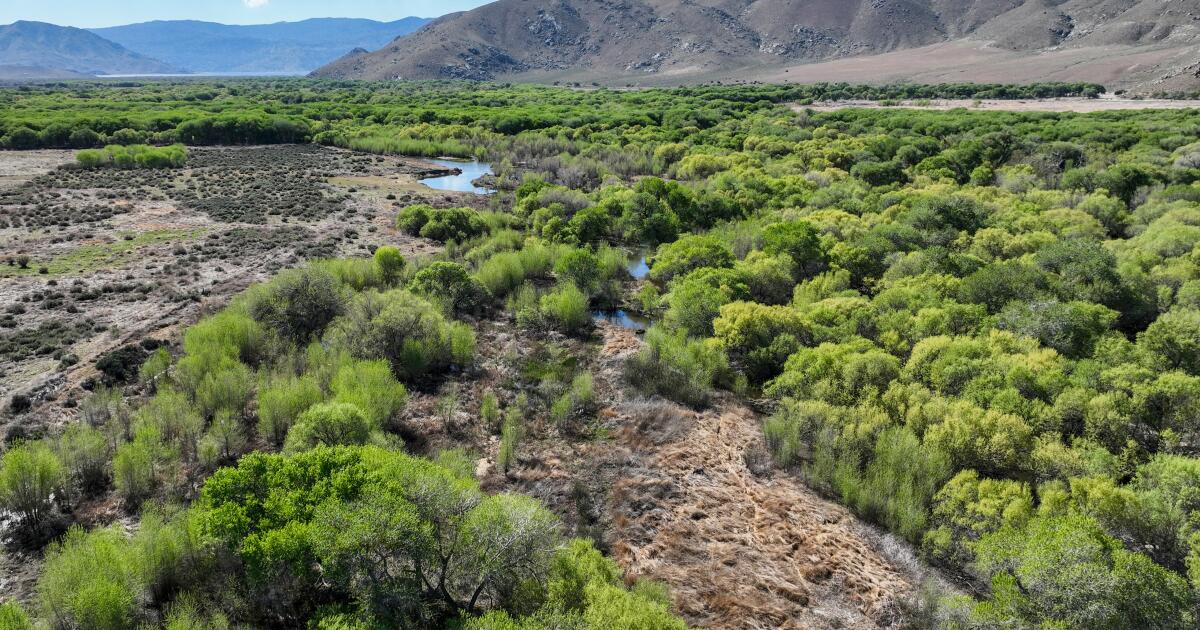
California is recognized as one of the world’s hotspots of biodiversity, with more species of plants and animals than any other state. And a significant number of the state’s species, from frogs to birds, live in habitats that depend on groundwater.
These rich ecosystems — including spring-fed streams, wetlands, riparian forests and oak woodlands — are vulnerable to declines in groundwater levels. In areas where unchecked pumping from wells severely depletes aquifers, once-thriving wetlands and forests can dry up and die.
Spotting threats to vulnerable natural areas has become a mission for Melissa Rohde, a hydrologist who has spent years analyzing satellite data and water levels in wells to come up with strategies for preventing ecosystems from being left high and dry.
“Nature has been getting the short end of the stick. It basically gets whatever is left behind, which oftentimes is not enough,” Rohde said. “How do we ensure that these ecosystems are protected?”
More than 300 species of birds have been seen at Kern River Preserve.
(Robert Gauthier / Los Angeles Times)
California is the only state with a groundwater law that includes provisions intended to protect groundwater-dependent ecosystems. But the law, adopted in 2014, gives considerable leeway to local agencies in developing water management plans that prevent “significant and unreasonable adverse impacts.”
When Rohde and other scientists examined the local plans for parts of the state that fall under regulation, they found only about 9% of groundwater-dependent ecosystems are adequately protected, while the remaining 91% are vulnerable.
When they looked at the entire state, they determined only 1% of the ecosystems are sufficiently protected under measures adopted to date.

Aggressive and impactful reporting on climate change, the environment, health and science.
Rohde has been focusing on finding ways to change that, in California and around the world.
Often working at home, she has pored over satellite data to spot decreases in vegetation greenness during drought, a telltale sign of die-off caused by declining aquifer levels. And she has analyzed how different types of trees, including willows, cottonwoods and oaks, fare when water levels fall depending on the depth of their roots.
Rohde and other researchers recently published a study outlining how California can set targets for maintaining groundwater levels — based on a formula including the type of vegetation, local water data and satellite imagery — to ensure the plants that anchor each ecosystem will be able to reach water and survive during dry times.
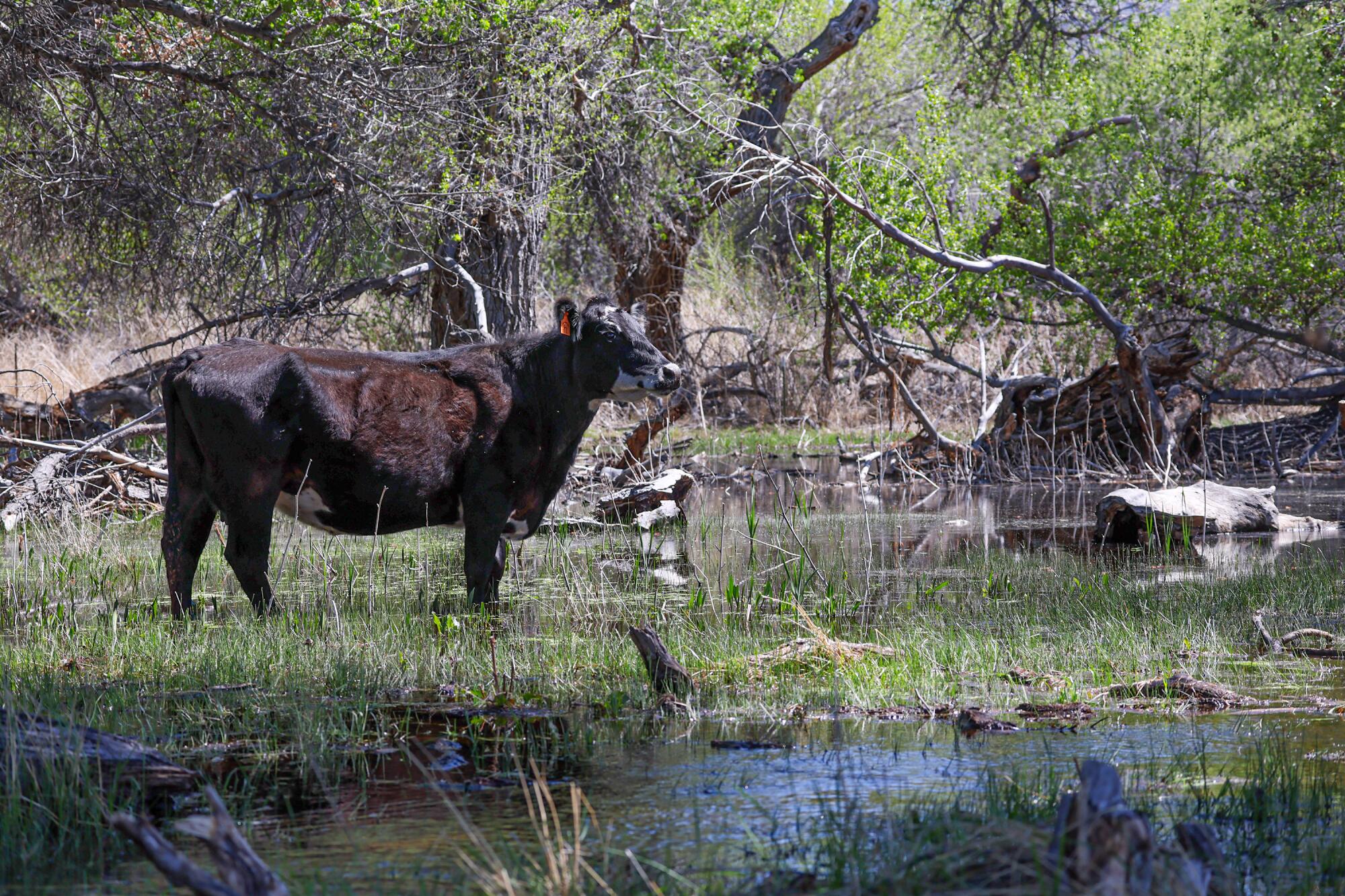
Cattle graze at the Kern River Preserve.
(Robert Gauthier / Los Angeles Times)
“If we don’t have groundwater levels that are able to support these diverse native vegetation ecosystems, then basically we run the risk of losing that important habitat for a lot of our threatened and endangered species,” Rohde said. “When you play around with keeping groundwater levels too deep to support the habitat, then you could lose species, and then that’s irreversible. The consequences can be severe.”
In California’s Mediterranean climate, trees, shrubs and the species they support are naturally adapted to drought. But excessive pumping from wells can push habitats beyond ecological limits by depleting the sources that sustain them.
With humanity’s heating of the planet intensifying droughts, the strains affecting these ecosystems continue to grow.
Already, California has lost the vast majority of its original wetlands to development, water diversions and agriculture. To avoid losing what remains, Rohde said, the state needs “a precautionary and preventative approach that can ensure that these ecosystems can withstand the intensification of droughts in climate change.”
During a recent visit to Kern County, Rohde and several conservation specialists walked in the shade through a lush forest of cottonwood trees near the south fork of the Kern River, visiting a nature preserve she had previously seen only in satellite images.
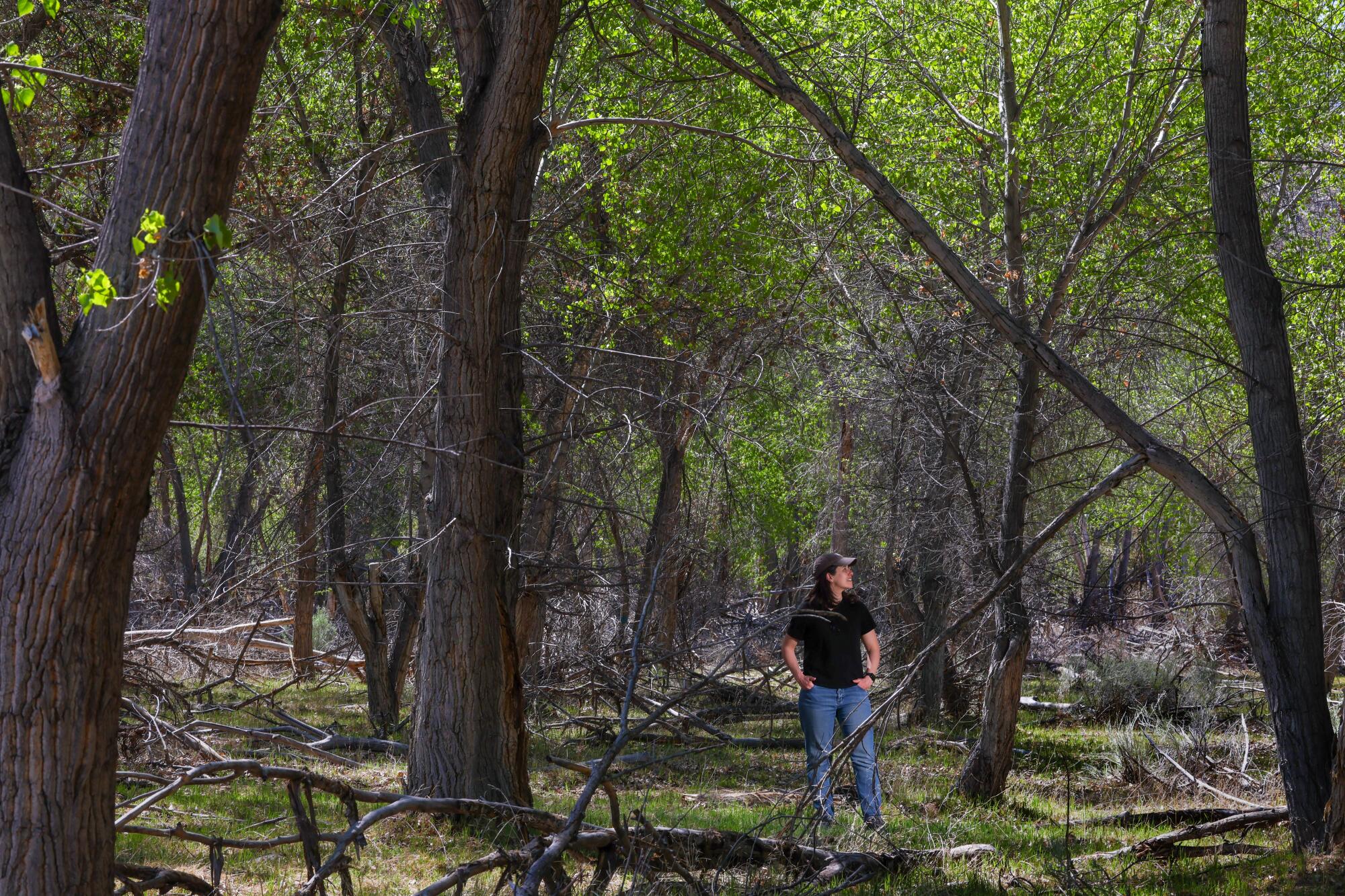
Scientist Melissa Rohde visits a riparian forest at the Kern River Preserve.
(Robert Gauthier / Los Angeles Times)
At the edge of a clearing, she came upon the bare, sunbleached skeletons of dead trees.
She said satellite data had revealed that parts of the forest died along this part of the Kern River during the drought between 2012 and 2016.
“That’s because the groundwater levels rapidly declined,” Rohde said.
After that die-off, she said, groundwater levels rebounded in the area, and the native vegetation has been growing back.
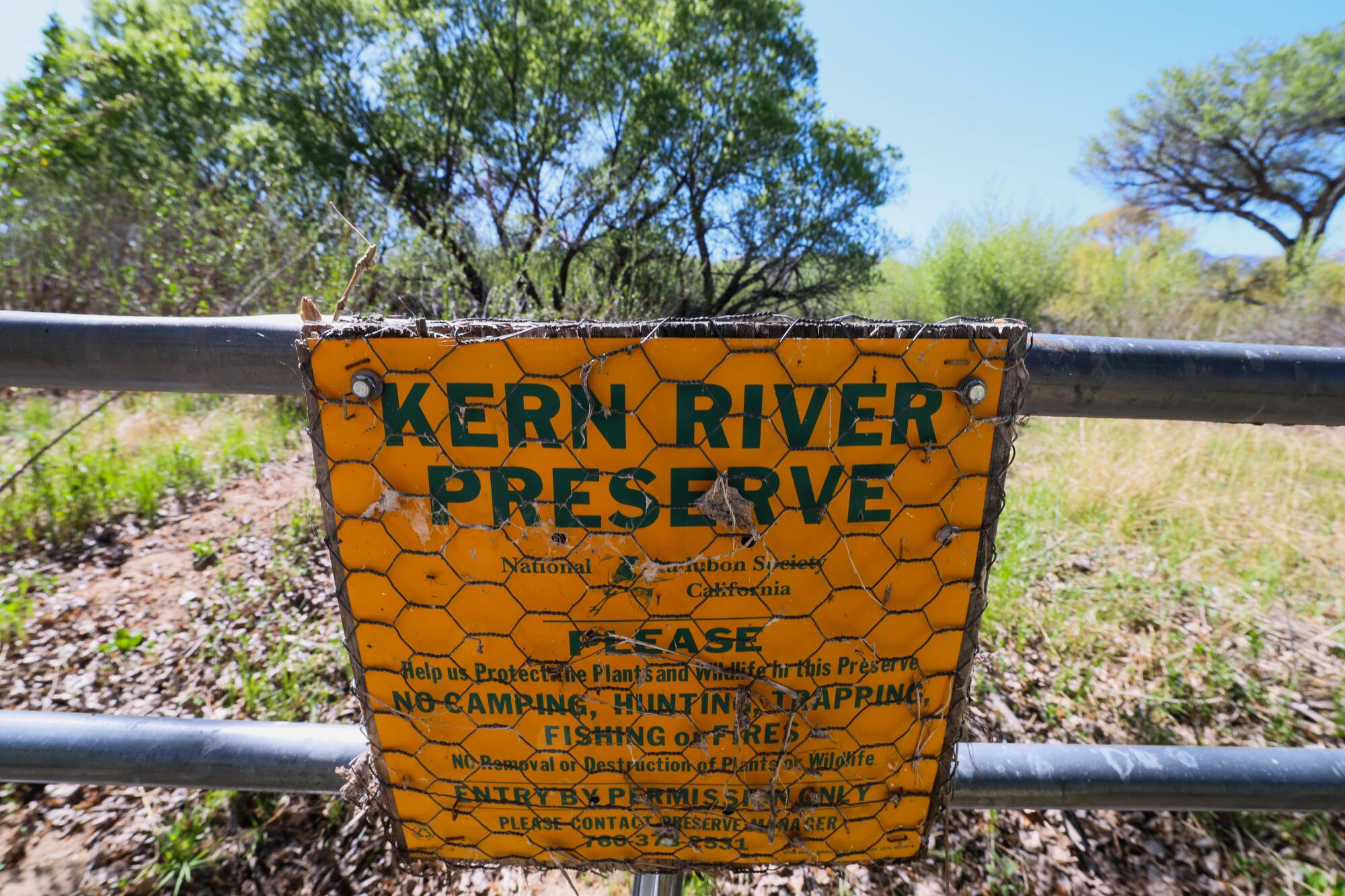
The Kern River Preserve protects the riparian ecosystem along the south fork of the Kern River.
(Robert Gauthier / Los Angeles Times)
It helps that this forest is protected as part of the Kern River Preserve, which is managed by the National Audubon Society, and that some nearby farmlands have been retired and converted to conservation lands over the years.
The preserve’s managers, working with the organization Ducks Unlimited, have also restored an expanded wetland by diverting water from the river and flooding a section of pastureland where cattle used to graze.
The wetland attracts birds, such as coots and tricolored blackbirds, and also recharges the aquifer that the roots of cottonwoods and willows tap into.
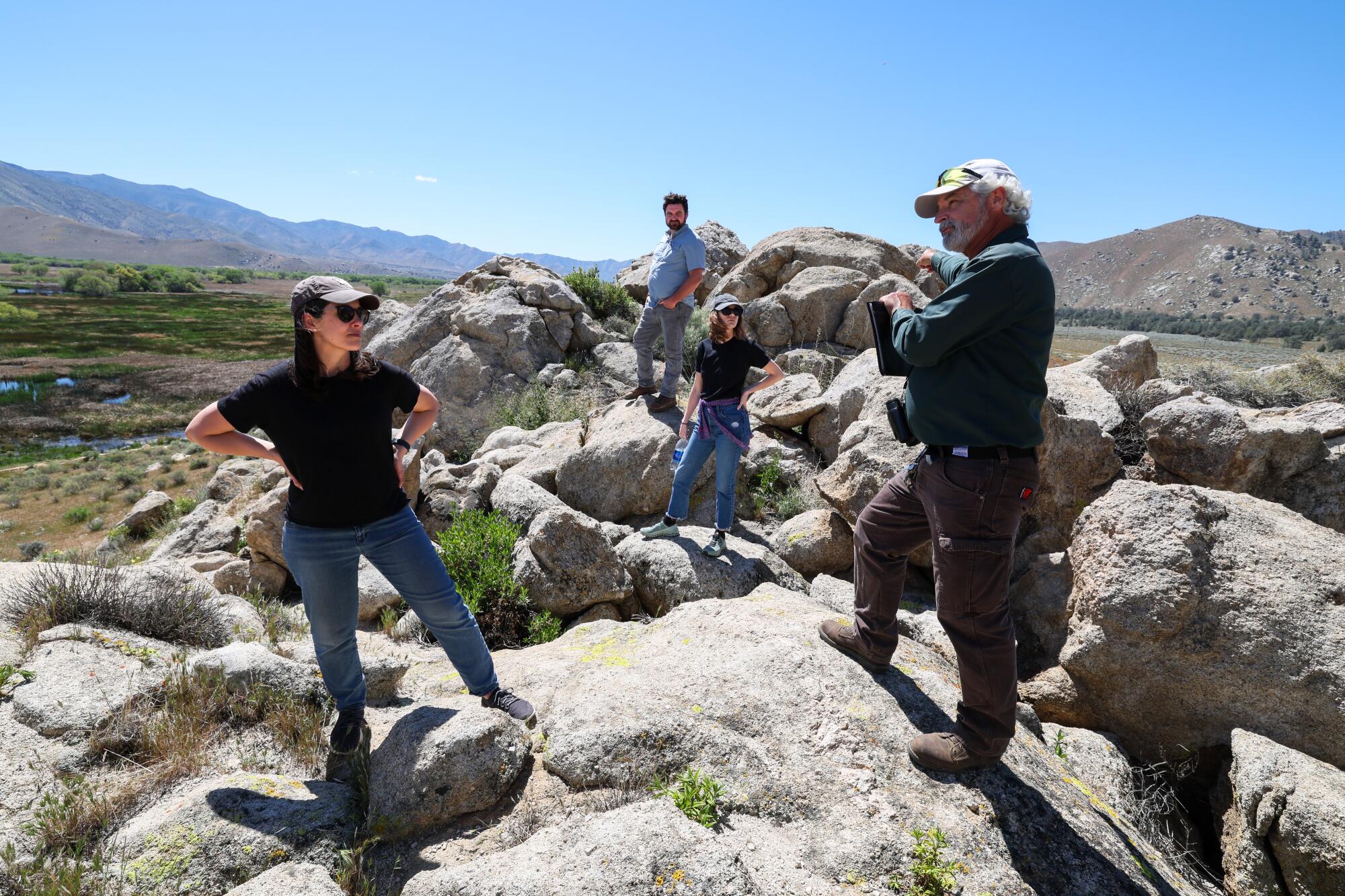
Scientist Melissa Rohde, left, and conservation specialists from Ducks Unlimited and the Audubon Society, including Reed Tollefson, right, stand on rocks overlooking a wetland at the Kern River Preserve.
(Robert Gauthier / Los Angeles Times)
The 3,300-acre preserve has expanded as adjacent alfalfa fields have been purchased and agricultural wells have been shut down, said Reed Tollefson, the preserve’s manager. These efforts have helped protect a refuge for birds including willow flycatchers and yellow-billed cuckoos.
As he pointed to several dead trees poking from the living cottonwoods, he said protecting the forest from groundwater pumping and climate change will require additional effort.
“I think it’s tenuous,” he said. “We’ve got more work to do to try and really sustain this.”
The dead trees that have appeared here and elsewhere in California over the past decade represent the sort of die-off that water managers need to focus on preventing, Rohde said.
“It has to be an intentional practice of setting thresholds, monitoring, using satellite data or other scalable means to measure the impacts, in order to make sure that we are not allowing this to happen on a wider scale,” she said. “From a biodiversity perspective, it’s absolutely critical.”
Rohde said she felt hopeful seeing the forest rebounding and much greener than it was several years ago, with many young trees coming up.
Some other parts of California haven’t fared nearly as well.
One rainy day last month, Rohde visited an area along the Santa Clara River in Ventura County where several hundred acres of willows and cottonwoods dried up and died during the drought in the mid-2010s.
When groundwater pumping by farms and communities caused aquifer levels to fall, many trees died along the river near the city of Fillmore.
“We saw this catastrophic drop in groundwater at this site,” Rohde said.
She visited the area with a research colleague and two managers from The Nature Conservancy. They stood on a gravel road next to a lemon grove, checking on what remained of the forest.
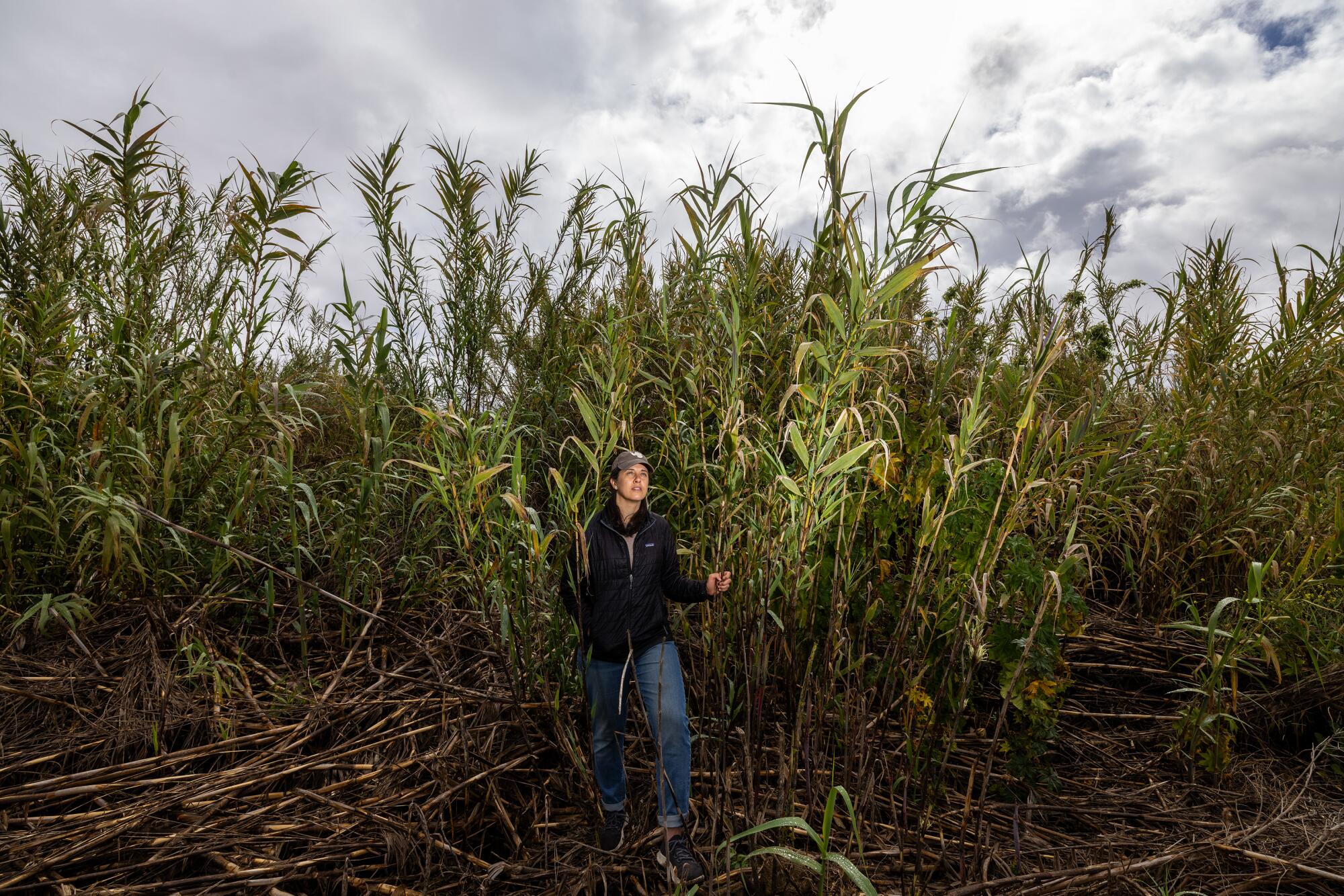
Scientist Melissa Rohde stands in a thicket of arundo, an invasive reed that has proliferated along parts of the Santa Clara River in Ventura County. There are ongoing efforts to remove the nonnative reeds in the area.
(Brian van der Brug / Los Angeles Times)
Where native trees died, an explosion of invasive reeds has taken over. The nonnative reeds, called arundo, have grown into thickets more than 20 feet tall. And unlike willows, Rohde said, arundo offers little value as habitat for birds.
“When we had that massive die-off, and the groundwater levels remained deep, there was no way for the native vegetation to regenerate,” she said. “But arundo is extremely efficient at extracting soil moisture. And so it was able to outcompete the native vegetation.”
She said efforts to prevent this sort of habitat degradation should be prioritized.
When managers of local agencies set goals for maintaining groundwater levels, she said, they can tailor targets to the type of vegetation — whether there are cottonwood trees, with roots averaging about 9 feet long, or oaks, with roots that average nearly 30 feet but can grow much deeper.
Her colleague Michael Bliss Singer said when native trees are ravaged by multiple years of low water levels, they will start losing leaves and then dropping branches.
In one study, Singer and others documented a “brown wave” of trees drying along the Santa Clara River between 2012 and 2016 — a loss they saw in satellite images.
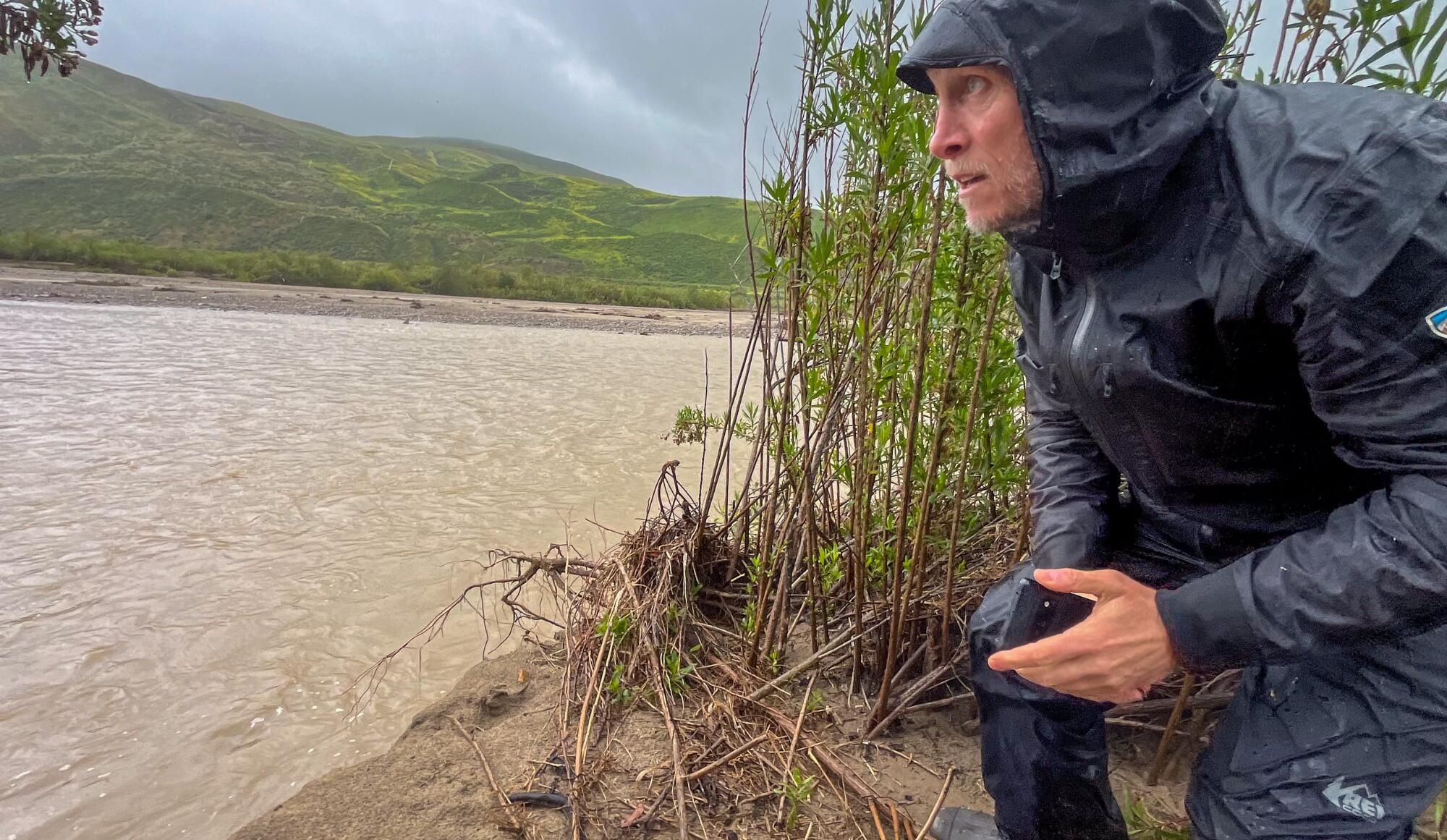
Scientist Michael Bliss Singer looks out over the Santa Clara River in Ventura County.
(Brian van der Brug / Los Angeles Times)
“It’s completely transformed the ecosystem here,” said Singer, a professor at Cardiff University in Wales who is also a researcher at UC Santa Barbara.
When plants die off like this and don’t recover, it’s a symptom of an ecosystem in decline. To prevent more of these losses in an era when climate change is driving more severe droughts, Singer said, it’s crucial to “come up with creative solutions for the worst-case scenario.”
Rohde has found in her research, however, that most local groundwater plans in California haven’t adequately accounted for climate projections.
Previously, Rohde did other types of climate research, including a stint in Antarctica in 2010, where she was part of a drilling team collecting ice cores. From that experience, Rohde said she realized that “I didn’t want to spend my career convincing people that climate change was an issue; I wanted to do something about it.”
She wore a faded cap with an Antarctica map, a memento of that trip. Rohde said her recent work is motivated by concerns about the climate crisis and biodiversity, as well as a conviction that proactive steps to protect ecosystems can make a difference.
“I have two young kids. I really want to make sure that I’m doing the best thing that I can to ensure a sustainable future for them, where they can access nature,” Rohde said.

E.J. Remson, a senior project director for The Nature Conservancy, surveys a wetland along the Santa Clara River in Ventura County.
(Brian van der Brug / Los Angeles Times)
“Often groundwater is out of sight, out of mind,” she said. “We don’t measure it, we don’t understand it and we misuse it. And we need to make sure that we are managing groundwater so that it is supporting us, and making sure that we have a sustainable future.”
Rohde now works as an independent scientist. Previously, as a researcher for The Nature Conservancy, she helped write an atlas of threatened and endangered species that rely on groundwater.
California’s groundwater-dependent ecosystems lie not only along streams, but also in habitats such as mountain meadows, coastal redwood forests and mesquite bushes among desert sand dunes. The species they support range from tiger salamanders to desert pupfish, and from songbirds to mammals such as ground squirrels and bighorn sheep.
“The risks are high when species are on the verge of extinction,” Rohde said.
Rohde and other scientists have found that ecosystems sustained by groundwater are under threat worldwide. Some of the few regions that have measures intended to protect them, she said, include Australia, the European Union and California.
Still, even with California’s groundwater regulations and endangered species laws, Rohde said, “we continue to miss the mark in actually protecting them.”
Rohde said state officials should give local water agencies clear direction to ensure they’re using science-based methods to safeguard ecosystems in their state-mandated plans. She said agencies can now use the approaches scientists have outlined to map strongholds of biodiversity and set targets for maintaining aquifer levels.
“It’s very attainable,” she said. “Now, it’s just basically up to political will, or enforcement by the Department of Water Resources, to ensure that that happens.”
Walking in the rain at the Santa Clara River Preserve, Rohde followed her former Nature Conservancy colleagues Peter Dixon and E.J. Remson on a trail through a stand of healthy trees.
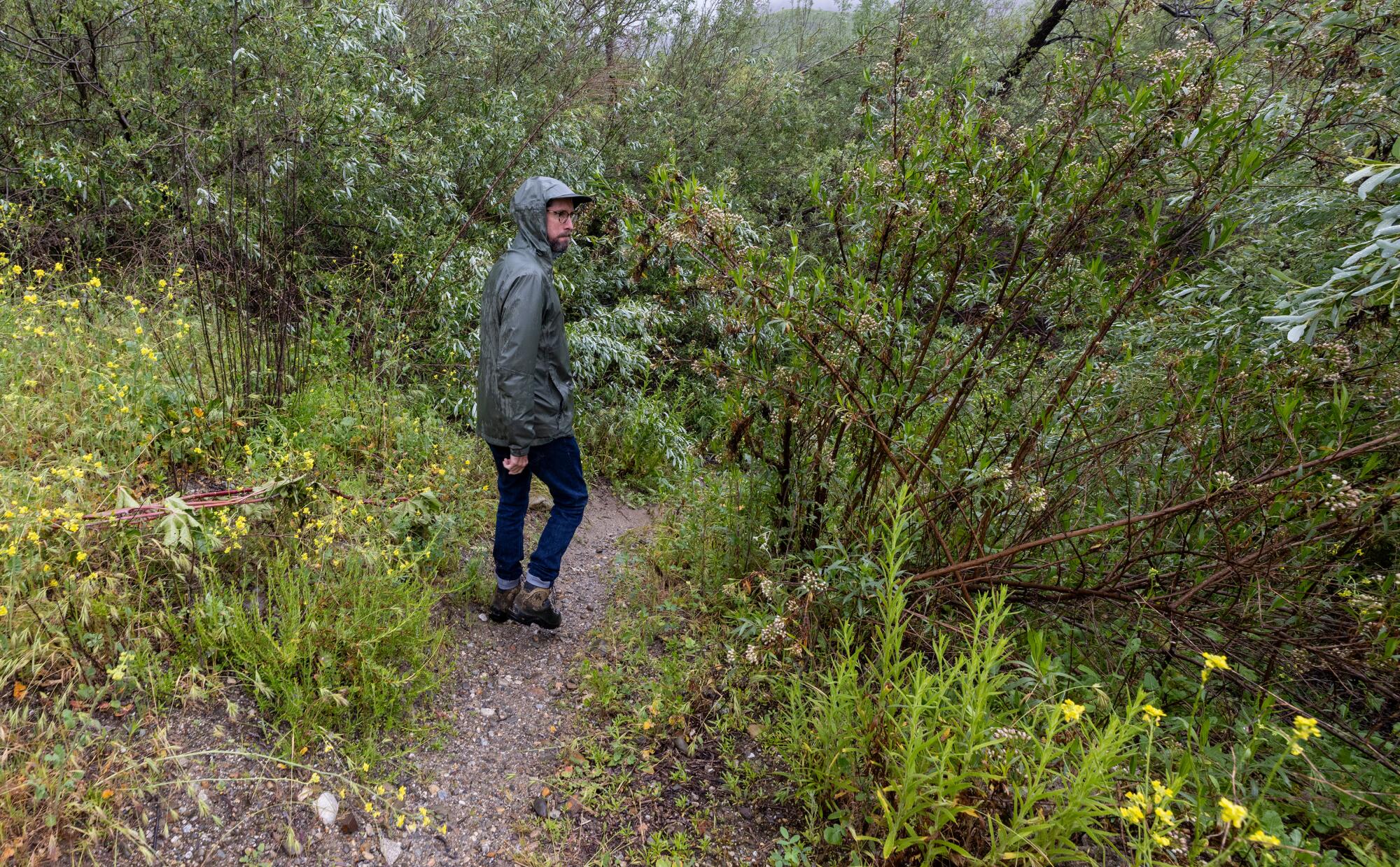
Peter Dixon, a project manager with The Nature Conservancy, walks on a trail through the riparian forest at the Santa Clara River Preserve.
(Brian van der Brug / Los Angeles Times)
They stood on the banks of the fast-flowing river, watching the muddy water churn past.
In the summer and fall, this part of the river usually dwindles to a trickle.
And during the next drought, when the river dries up, the forest will depend on the same groundwater that nearby communities and farms also use.
If the water needs of this and other ecosystems aren’t prioritized, Rohde said, vital habitats will suffer.
“We need to be deliberate about the planning, and ensuring that they get their fair share,” she said. “Their existence is potentially imperiled if we don’t act.”
Science
Opinion: Most older Americans who need hearing aids don't use them. Here's how to change that

Having depended on hearing aids for nearly three decades, I’m astounded by the lack of Medicare coverage for devices that can solve a problem afflicting tens of millions of older Americans.
Nearly two-thirds of Americans over age 70 have some degree of hearing loss, and over half of those 75 and older experience impairment serious enough to be considered disabling. But most don’t wear hearing aids.
Because the legislation that created Medicare nearly 60 years ago specifically excluded hearing aids, those who rely on the program’s traditional coverage must pay for them out of pocket. That expense is among the chief barriers to wider use of the devices.
Age-related hearing loss impedes basic communication and the relationships that depend on it. Expanded access to hearing aids could therefore do no less than enable more older Americans to establish and maintain the social connections that are essential to a meaningful life.
Hearing loss is like an invisible, muffling curtain that falls in front of anyone speaking. Asking people to repeat themselves can yield irritated and hurtful responses. And it’s hopeless to ask a soft-spoken person to speak up. Sometimes it’s easier just to nod and smile.
Many older people I know choose to avoid social gatherings altogether because they can’t hear well. Without hearing aids, I’d stay home too.
Hearing loss can harm one’s health in other ways. For example, I’ve written about the need for a comprehensive approach to reducing cancer risk at older ages, including preventive services such as colorectal cancer screening. But these services rely on conversations between patients and their healthcare providers. An older patient’s ability to hear and understand such conversations shouldn’t be taken for granted or ignored.
The Food and Drug Administration did improve access to hearing aids by making some of them available without a prescription in 2022, but the over-the-counter devices are inadequate for serious hearing loss like mine. My private health insurance, meanwhile, started covering hearing aids a few years ago, providing up to $2,500 for them every five years. One hearing aid alone can cost that much or more, however.
Despite its limitations, my private coverage for hearing aids is better than nothing, which is what traditional Medicare provides.
Hearing loss is more common among lower-income people and those without advanced education. The toll from noisy workplaces compounds age-related hearing loss for some. One analysis found that most Americans with a serious hearing disability can’t afford the typical price of hearing aids.
Many of the older adults who can’t come up with these significant out-of-pocket expenses spent their working years in low-wage jobs that our country depends on. Denying them treatment for their hearing loss is a lousy way to treat people who gave years of service to our society.
Although some older adults with hearing loss won’t benefit from hearing aids, Medicare coverage for the devices might encourage more beneficiaries to get their hearing tested so they can get the treatment that’s right for them. And while Medicare coverage alone won’t address the stigma some people associate with hearing aids, the availability of newer, more comfortable and less obvious technology might win over some refuseniks.
Legislation reintroduced with bipartisan support last year would finally correct this glaring gap in Medicare coverage by removing the hearing aid exclusion from the law. There’s no reason to delay action on this any longer. Are our representatives listening?
Mary C. White is an adjunct professor of environmental health at Emory University’s Rollins School of Public Health, a Public Voices fellow at AcademyHealth in partnership with the OpEd Project and a former federal epidemiologist.
Science
Second human case of bird flu detected in Michigan dairy worker

A second human case of bird flu in a diary worker has been confirmed in Michigan, state and federal health officials announced Wednesday.
The symptoms were mild, consisting of conjunctivitis. The Texas dairy worker who contracted the virus in March also came down with pink eye.
At a press call on Wednesday, Nirav Shah, principal deputy director of the U.S. Centers for Disease Control and Prevention, said the finding was “not unexpected” and that it was a scenario “that we had been preparing for.”
He said that since the discovery of H5N1 in dairy cattle, state and federal health officials have been closely monitoring farmworkers and slaughterhouse workers and urging farmers and farmworker organizations to “be alert, not alarmed.”
Federal officials say they still believe the human health risk of bird flu is low; however, it underscores the need for people who are interacting with infected or potentially infected farm animals or birds to take precautions, including avoiding dead animals and wearing personal protective equipment (PPE) if there’s a need to be in close contact.
Though a nasal swab from the person in Michigan tested negative for influenza, an eye swab from the patient was shipped to the CDC and tested positive for influenza A(H5N1) virus.
This is the third case of H5N1 reported in the United States. A poultry worker in Colorado was identified in 2022.
Although the symptoms in the three farmworkers in the U.S. have been mild, people elsewhere in the world have suffered more severe illness, including death. According to the World Health Organization, between Jan. 1, 2003, and March 28, 2024, there have been 888 cases of human infection from 23 countries; 463 were fatal.
In preparation for a more widespread outbreak, the CDC updated its guidance for PPE in dairies and issued a nationwide order for healthcare providers to be on the lookout for novel influenza.
On Tuesday, the CDC asked clinical laboratories and health departments to increase the number of influenza samples being analyzed “to maximize the likelihood of catching a case of H5N1 in the community,” Shah said.
The US Department of Agriculture is also expanding its surveillance and support by providing $1500 to non-infected farms to beef up biosecurity, and $100 to producers who want to buy inline samplers to test their milk. The agency will also provide $2000 per farm to cover veterinary fees for testing, as well as shipping costs to send those tests to laboratories for analysis.
There have been no cases of H5N1 detected in California’s dairy herds.
Officials said ongoing analysis of the nation’s dairy supply suggests it is safe to consume, Despite the risk to human health being low, an official with the Administration for Strategic Preparedness and Response said it will make Tamiflu available upon request “to jurisdictions that do not have their own stockpile and are responding to pre-symptomatic persons with exposure to confirmed or suspected infected birds, cattle or other animal exposures.”
Dawn O’Connell, assistant secretary of the preparedness agency, said it started the “fill and finish” process for approximately 4.8 million doses of vaccine “that is well matched to the currently circulating strain of H5N1 through the national pre-pandemic influenza vaccine stockpile program.”
She said the decision to get started on H5N1 vaccines was not a response to any heightened concern, but since it takes several months to fill and finish vaccine doses, the agency “thought it made sense given what we were seeing.”
-

 Movie Reviews1 week ago
Movie Reviews1 week ago‘The Substance’ Review: An Excellent Demi Moore Helps Sustain Coralie Fargeat’s Stylish but Redundant Body Horror
-

 Movie Reviews1 week ago
Movie Reviews1 week ago‘Rumours’ Review: Cate Blanchett and Alicia Vikander Play Clueless World Leaders in Guy Maddin’s Very Funny, Truly Silly Dark Comedy
-

 Movie Reviews1 week ago
Movie Reviews1 week ago‘Blue Sun Palace’ Review: An Intimate, Affecting and Dogma-Free Portrait of Chinese Immigrants in Working-Class New York
-

 News1 week ago
News1 week agoVideo: A Student Protester Facing Disciplinary Action Has ‘No Regrets’
-

 Culture1 week ago
Culture1 week agoFrom Dairy Daddies to Trash Pandas: How branding creates fans for lower-league baseball teams
-

 World1 week ago
World1 week agoPanic in Bishkek: Why were Pakistani students attacked in Kyrgyzstan?
-

 Politics1 week ago
Politics1 week agoAnti-Israel agitators interrupt Blinken Senate testimony, hauled out by Capitol police
-

 News1 week ago
News1 week agoCity of Kyle falls short of ‘Kyle’ world record
















